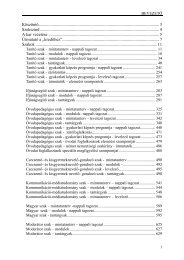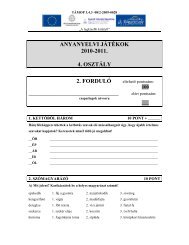ACTA SZEKSZARDIENSIUM - Pécsi Tudományegyetem Illyés Gyula ...
ACTA SZEKSZARDIENSIUM - Pécsi Tudományegyetem Illyés Gyula ...
ACTA SZEKSZARDIENSIUM - Pécsi Tudományegyetem Illyés Gyula ...
You also want an ePaper? Increase the reach of your titles
YUMPU automatically turns print PDFs into web optimized ePapers that Google loves.
Krisztina Jász<br />
characteristics of the Hungarian regions in terms of social exclusion, arguing that interventions<br />
with a different focus are perfectly justified owing to them having such differing characteristics. 22<br />
● Southern Great Plain Region (Dél-Alföld): social exclusion mainly affects aging<br />
residents living alone in regions with scattered farmsteads and in border regions;<br />
multiple disadvantages are primarily due to difficult geographical access and a<br />
scarcity of public utilities; a significantly high proportion of persons with addiction<br />
and mental disorders, with a marked presence of various forms of deviance.<br />
● Central Hungarian Region (Közép-Magyarország): phenomena arising from<br />
unaddressed social problems, homelessness in particular, are concentrated here; as<br />
a result, certain zones are undergoing ghettoisation; furthermore, the indigenous<br />
poor who live in dynamically developing settlements and receive practically no<br />
social support continue to pose a real challenge to the social welfare system.<br />
● Southern Transdanubia Region (Dél-Dunántúl): a settlement structure where<br />
small villages are dominant, the isolation, in both relative and absolute terms, of<br />
townships and the overrepresentation of the Roma population in some regions 23 have<br />
all contributed to the current peripheral status of the region; a low level of schooling and<br />
the region’s peripheral status from the perspective of accessibility reinforce each other.<br />
● Northern Hungarian Region (Észak-Magyarország): child poverty is the most<br />
serious problem facing the region; the presence of ethnicity-based segregation is<br />
also strong; the social welfare system available to local residents is run by persons<br />
working either part-time or on their own.<br />
● Central Transdanubia Region (Közép-Dunántúl): one of the Hungarian regions<br />
where a favourable economic and employment situation does not improve social<br />
chances evenly, i.e. an economically advantageous situation does not automatically<br />
translate into social advantages for disadvantaged groups; the proportion of the<br />
indigenous poor with a low level of schooling and living a long way from zones of<br />
development is also high here.<br />
● Western Transdanubia Region (Nyugat-Dunántúl): residents in problem regions<br />
hidden behind macro-data often remain ‘invisible’ for a social welfare system that<br />
has not been properly developed; compared to the national average, the cost of<br />
living is very high in the region; as a result, the proportion hit by expenditure and<br />
consumption poverty is increasingly high.<br />
● North Great Plain Region (Észak-Alföld): It is here that the number and the size of<br />
the areas that are the worst hit by social exclusion are the largest. Of the factors giving<br />
rise to the emergence of social exclusion, here in Hungary spatial disadvantages and<br />
ethnicity are the most important.<br />
22 Documents serving as sources of summary: shortened working versions of regional analyses.<br />
23 This paper uses the terms ‘Gypsy’ and ‘Roma’. The official designation of the ethnic minority group is<br />
‘Gypsy’, while daily parlance uses the more presentable and politically more correct ‘Roma’. The word<br />
‘Roma’ originates from the word ‘rom’ meaning ‘man’ in the Lovari language. As, from among the Roma<br />
ethnic groups living in Hungary, the Beás group does not speak Lovári, many of them prefer to use the<br />
word ‘Gypsy’ The same applies to some Romungros as well. Both terms are used in today’s academic and<br />
public parlance alike.<br />
272




